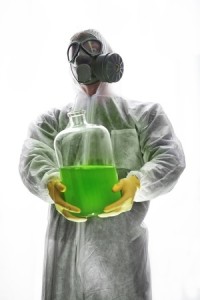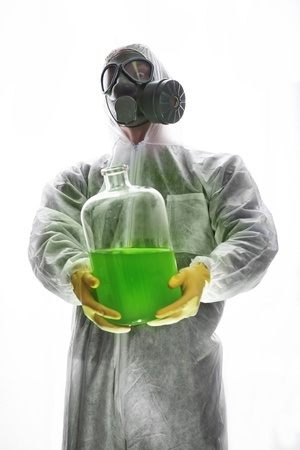
The DEA posted maps of the total number of meth lab incidents from 2004 through 2014. There were 23,829 total incidents in 2004; 6,858 in 2007; 13,432 in 2012; and 9,306 in 2014. Missouri, Tennessee and Iowa were the state with the highest amounts of reported meth lab accidents in 2004; Indiana, Missouri, and Tennessee for 2014. Many states throughout the US had dramatic decreases in reported accidents. That’s the good news. The bad news is that a CDC study indicates injuries from methamphetamine-related incidents are on the rise in some parts of the country.
The CDC report noted there was an increase of reported incidents from 2001 through 2004; followed by decreases through 2007; with increases again through 2012. In 7% of the meth-related incidents, 162 people were injured, including 26 children (16%). Among the injured, 136 (84%) were treated at a hospital, including 19 of the injured children. There were also two reported deaths: one probable meth cook and one law enforcement official.
The percentage of incidents with injured persons increased from less than 5% during 2001-2004 and 2005-2007 to 10% during 2008-2012. Most of the injuries were to members of the general public (97) and law enforcement officials (42). The most frequently reported injuries overall were: respiratory irritation, burns and eye irritation. Burn injuries were almost exclusively experienced by the general public, with 42 of the 44 reported injuries.
The researchers speculated that the initial declines in injuries were related to state and federal restrictions on the retail sales of common meth precursor drugs, ephedrine and pseudoephedrine. This was reversed in 2008 when meth cooks adapted by buying permitted quantities from multiple locations, often with false identification. Additionally, a new method for making meth became popular, one called “shake-and-bake.” This involves shaking smaller amounts of the precursor chemicals in a 2 liter plastic bottle. Unfortunately, the bottles frequently burst, causing burns and environmental contamination. “Burn injuries increased during this time, particularly to members of the public, who might have been meth cooks or household residents.”
Children who are present during the production of meth face many hazards. The Horton et al. study cited below reported that half the events with injured children occurred between midnight and 6 am, when most children are asleep. The authors speculated that sleeping children have an even higher risk of acute injury during an emergency event. “This is particularly true if the parents/care givers are in another part of the house and/or are under the influence of meth.” Several states have enacted laws to protect children from meth-related injuries.
A 2003 study by Horton et al. examined data from Hazardous Substances Emergency Events Surveillance (HSEES Events) identified eight children injured in meth events. “Five of the meth events with children occurred in private residences: three of which occurred in houses, one in an apartment building, and one in a duplex.” One of the children injured was 8 years-old. They concluded:
The HSEES data appear to indicate that the numbers of meth labs and associated emergency events will continue to increase, putting more children and other unsuspecting individuals at risk for hazardous substance(s) exposure. More action is needed to remove children from these dangerous environments and to educate innocent bystanders, as well as the substance abusers themselves, about the risks involved with meth and its illicit production.
A 2009 study by Thrasher et al., using case reports from the Washington State Poison Control Center found that a large proportion of meth lab exposures occurred in private households. Of the 198 exposed persons, 10.6% were meth cooks, 15.7% were law enforcement personnel, 35.4% were residents and 38.3% were classified as other. Twenty-eight of the reported exposures (19.2%) were children. “A subject’s own residence was the predominant site of exposure for cooks (71%), other adults (41%), and children (66%).”
Although the CDC study indicated recent increases in an increase in meth-related injuries, there is distinct likelihood the true incidence is significantly under reported. One limitation of the CDC study was that only five states were included. Now this was because those five states (Louisiana, Oregon, Utah, New York, and Wisconsin) were the only ones with complete information available for the time period 2001-2012. Another limitation was that meth incidents in homes were not included in the original data from the National Toxic Substance Incidents Program (NTSIP) unless there was a public health action, such as an evacuation.
| Total Meth Incidents 2004 | Total Meth Incidents 2014 | |
| Oregon | 632 | 1 |
| Utah | 107 | 1 |
| Wisconsin | 109 | 14 |
| Louisiana | 176 | 11 |
| New York | 136 | 197 |
| Missouri | 2,913 | 1,034 |
| Tennessee | 2,341 | 958 |
| Iowa; Ohio (2014) | 1,666 | 919 |
| Illinois; Michigan (2014) | 1,576 | 750 |
| Indiana | 1,377 | 1,471 |
One illustration of this under reporting can be seen by examining the incidents reported in the DEA maps for those five states included in the CDC study to the incidents in the five states with the highest reported incidents in 2004 and 2014. The five states included in the CDC study were: Oregon, Utah, Wisconsin, Louisiana, and New York. The five states with the highest reported incidents in 2004 were: Missouri, Tennessee, Iowa, Illinois, and Indiana. The five states with the highest reported incidents in 2014 were: Missouri, Tennessee, Indiana, Michigan, and Ohio. The total meth incidents for the five states in the CDC study, for 2004 AND 2014 were less than the incidents for just one of the top five states—for both 2004 and 2012. Another readily noticeable fact is that the highest incident states for both 2004 and 2014 cluster in the Midwest, with the border states of Tennessee and Kentucky thrown in for good measure.
We can say there was an increase for the five states included in the CDC study, but can’t assume that increase holds throughout the US. It is likely the real total is much higher, especially in the selected states from the DEA map noted here.
The Department of Justice has produced a handy pamphlet of “Fast Facts” about meth labs. It described signs to look for if you suspect the presence of a meth lab. These signs include: unusual odors; excessive trash, especially chemical containers, coffee filters, red stained pieces of cloth, and duct tape rolls. Other indications are secretive, unfriendly occupants; frequent visitors, esp. at unusual hours; curtained or blackened windows; extensive security measures or attempts to ensure privacy, such as “no trespassing” or “beware of dog” signs.
Meth labs come in all sizes. Super labs produce 10 pounds or more of meth at a time; smaller “box” labs produce as little as an ounce and can fit in a box or backpack. They can be located almost anywhere: private homes, hotels and motels, automobiles, boats and luggage. They can also be found in commercial and industrial districts; or nestled away in a secluded rural area.
The chemical used to produce methamphetamine are extremely dangerous. Some are very volatile and could ignite if not handled properly, as apparently was the case in the motel video mentioned below. Even if there is not fire or explosion, meth production is dangerous. Exposure to the chemical can pose a series of health risks, including respiratory problems, severe chemical burns, pulmonary edema, and more. Look at a table in the pamphlet listing various chemicals used in meth labs and the hazards associated with them.
Health Research Funding posting some facts about meth lab explosions and also had two embedded videos of meth lab explosions. One video shows a mobile home in a rural setting going up in smoke. The other captured an explosion in a motel room on a security camera. Seven burn units have shut down over the last six years because of the unreimbursed costs of treating burn victims in meth lab explosions. One pound of meth results in six pounds of toxic waste. Eighty percent of the meth labs found and dismantled by authorities used the “shake and bake” method.
The simplified “shake and bake” method and smaller size of these labs means that rolling meth labs in cars, trailers or mobile homes can be easily moved to a secluded location where the manufacturing fumes can’t be detected and the toxic waste discarded. In 2002, Interstate 24 in southwest Kentucky was temporarily shut down when a car containing anhydrous ammonia exploded. It was a rolling meth lab. “Trucking down the highway allows them to disperse the rotten egg smell the labs produce and keep the waste out of their own homes.” Of the 2,000 chemicals that could be used to make meth, at least half are explosive.
Illustrating how meth labs can be found anywhere, here is an article about an explosion that occurred at a federal facility in Gaithersburg, MD. The explosion happened on the main campus of the National Institute of Standards and Technology (NIST) on June 19th, 2015. Federal law enforcement officials found pseudoephedrine, drain opener and a recipe for making methamphetamine in the lab. Representative Lamar Smith wrote in a letter to the Commerce Secretary said: “I am troubled by the allegations that such dangerous and illicit activity went undetected at a federal research facility.”





